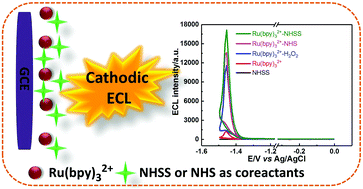High-efficiency cathodic electrochemiluminescence of the tris(2,2′-bipyridine)ruthenium(ii)/N-hydroxy compound system and its use for sensitive “turn-on” detection of mercury(ii) and methyl blue†
Abstract
N-Hydroxysuccinimide (NHS) and N-hydroxysulfosuccinimide (NHSS) were exploited as efficient coreactants for cathodic Ru(bpy)32+ electrochemiluminescence (ECL) in neutral medium. The developed systems showed stronger ECL signals than that of the classic Ru(bpy)32+–H2O2 system and have been exploited for sensitive “turn-on” type ECL detections of methyl blue and Hg2+.



 Please wait while we load your content...
Please wait while we load your content...